
Dactylorhiza fuchsii, the common spotted orchid, is a species of flowering plant in the orchid family Orchidaceae.

Pollination is the transfer of pollen from an anther of a plant to the stigma of a plant, later enabling fertilisation and the production of seeds, most often by an animal or by wind. Pollinating agents can be animals such as insects, birds, and bats; water; wind; and even plants themselves, when self-pollination occurs within a closed flower. Pollination often occurs within a species. When pollination occurs between species, it can produce hybrid offspring in nature and in plant breeding work.

Alpine plants are plants that grow in an alpine climate, which occurs at high elevation and above the tree line. There are many different plant species and taxa that grow as a plant community in these alpine tundra. These include perennial grasses, sedges, forbs, cushion plants, mosses, and lichens. Alpine plants are adapted to the harsh conditions of the alpine environment, which include low temperatures, dryness, ultraviolet radiation, wind, drought, poor nutritional soil, and a short growing season.

Eryngium alpinum, the alpine sea holly, alpine eryngo or queen of the Alps, is a herbaceous perennial plant in the family Apiaceae.

Zeuxine, commonly known as verdant jewel orchids, is a genus of about eighty species of orchids in the tribe Cranichideae. They are native to parts of tropical Africa, Asia, Southeast Asia, New Guinea, Australia and some Pacific Islands. They have relatively narrow, dark green leaves and small, dull-coloured resupinate flowers with the dorsal sepal and petals overlapping to form a hood over the column. The labellum has a pouched base and its tip has two lobes.

A flower, sometimes known as a bloom or blossom, is the reproductive structure found in flowering plants. Flowers produce gametophytes, which in flowering plants consist of a few haploid cells which produce gametes. The "male" gametophyte, which produces non-motile sperm, is enclosed within pollen grains; the "female" gametophyte is contained within the ovule. When pollen from the anther of a flower is deposited on the stigma, this is called pollination. Some flowers may self-pollinate, producing seed using pollen from the same flower or a different flower of the same plant, but others have mechanisms to prevent self-pollination and rely on cross-pollination, when pollen is transferred from the anther of one flower to the stigma of another flower on a different individual of the same species.

Pancratium is a genus of African and Eurasian perennial, herbaceous and bulbous plants in the Amaryllis family, subfamily Amaryllidoideae

Ponta dos Rosais is a promontory located along the northwestern coast of the parish of Rosais, municipality of Velas, on the island of São Jorge in the Portuguese archipelago of the Azores.

Cypripedium calceolus is a lady's-slipper orchid, and the type species of the genus Cypripedium. It is native to Europe and Asia.
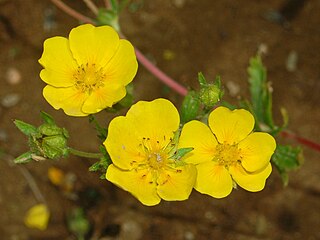
Potentilla delphinensis is a herbaceous perennial species of cinquefoil belonging to the family Rosaceae. It is endemic to France, where it is limited to the southern French Alps.
Coincya cintrana is a flowering plant of the family Brassicaceae. It is a hemicryptophyte plant, and it grows on walls, in steep areas and in rocky slopes. It flowers from April until June.
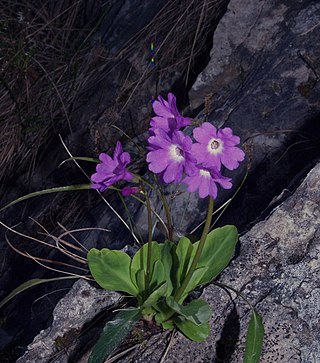
Primula carniolica is a flowering plant in the primrose family known by the common name Carniolan primrose. It is endemic to Slovenia.
Plant cryopreservation is a genetic resource conservation strategy that allows plant material, such as seeds, pollen, shoot tips or dormant buds to be stored indefinitely in liquid nitrogen. After thawing, these genetic resources can be regenerated into plants and used on the field. While this cryopreservation conservation strategy can be used on all plants, it is often only used under certain circumstances: 1) crops with recalcitrant seeds e.g. avocado, coconut 2) seedless crops such as cultivated banana and plantains or 3) crops that are clonally propagated such as cassava, sweet potato.

Aquilegia ottonis is a species of flowering plant in the buttercup family. It has a broad distribution in Europe; it is native to Greece, Italy, and Albania. Plants produce blue-purple flowers which, based on pollination syndromes, are thought to be pollinated by bumblebees. A. ottonis is named after King Otto of Greece; the specific epithet 'ottonis' is the third declension of 'otto'.
Helmut Mayrhofer is an Austrian lichenologist. He is known for his expertise on the lichen family Physciaceae and his studies of the lichen flora of the Balkan Peninsula, the Alps, and other regions.

Gentiana froelichii, commonly known as the Karawanken gentian, is an endemic hemicryptophyte and perennial plant species in the family Gentianaceae, which occurs in southeastern Alps. It can be found in Austria and Slovenia, with a few reported occurrences happening in Italy.

Cerastium subtriflorum, the Slovenian mouse-ear chickweed, is a perennial plant species in the family Caryophyllaceae. It is mostly restricted to the Slovenian and Italian Alps.
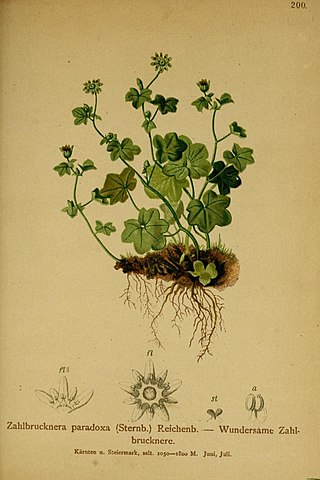
Saxifraga paradoxa, commonly known as the fragile saxifrage, is a perennial plant species in the family Saxifragaceae, which occurs as a tertiary relict and endemic Saxifraga species in the South-Eastern Alps. Count Kaspar Maria von Sternberg described this species in his work Revisio Saxifragarum iconibus of 1810.
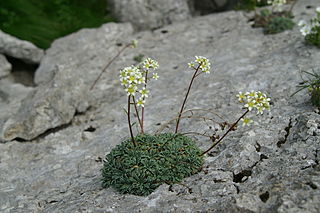
Saxifraga crustata, the crusted-leaved saxifraga and silver saxifrage, as well as encrusted saxifrage, is an evergreen perennial plant species in the family Saxifragaceae, native to the Eastern Alps. This species was described by Austrian botanist Lorenz Chrysanth von Vest in 1804.
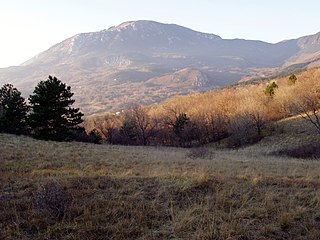
Čaven is a ridge above the Vipava Valley in southwestern Slovenia. It constitutes the southern rim of the Trnovo Forest Plateau in the northern Dinaric Alps. Its highest peak is Big Modrasovec, its slightly lower peak is Little Modrasovec, and the most scenic peak is Kucelj. The peak Čaven in the west of the ridge has an altitude of 1185 m. Čaven may be ascended by trail from Predmeja, Stomaž, and Lokavec. From Čaven, one may view the Vipava Valley and the landscape to the Adriatic Sea. Two other nearby peaks are Sekulak and Big Edge. Between Veliki Modrasovec and Mala Gora 1034 m a.s.l.), there is Anton Bavčer Lodge at Čaven. Čaven is built of upper Jurassic limestone. Next to the road on Selovec, there is a prominent reef limestone site with fossils of coral colonies and hydrozoans. Čaven is the growing site of various brooms (Genista) and of the endemic herbaceous perennial Hladnikia pastinacifolia.






















